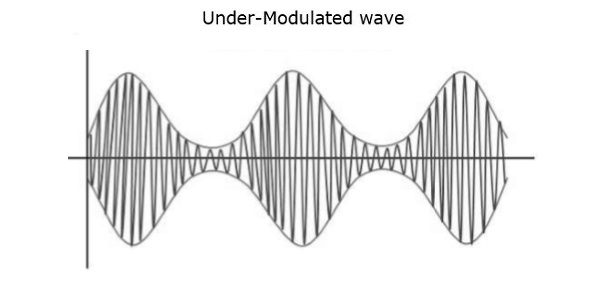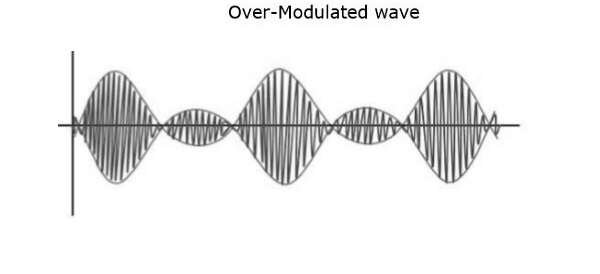Mathematical Expressions
Following are the mathematical expressions for these waves.
Time-domain Representation of the Waves
Let the modulating signal be,
and the carrier signal be,
Where,
and are the amplitude of the modulating signal and the carrier signal respectively.
and are the frequency of the modulating signal and the carrier signal respectively.
Then, the equation of Amplitude Modulated wave will be
(Equation 1)
Modulation Index
A carrier wave, after being modulated, if the modulated level is calculated, then such an attempt is called as Modulation Index or Modulation Depth. It states the level of modulation that a carrier wave undergoes.
Rearrange the Equation 1 as below.
(Equation 2)
Where, is Modulation index and it is equal to the ratio of and . Mathematically, we can write it as
(Equation 3)
Hence, we can calculate the value of modulation index by using the above formula, when the amplitudes of the message and carrier signals are known.
Now, let us derive one more formula for Modulation index by considering Equation 1. We can use this formula for calculating modulation index value, when the maximum and minimum amplitudes of the modulated wave are known.
Let and be the maximum and minimum amplitudes of the modulated wave.
We will get the maximum amplitude of the modulated wave, when is 1.
(Equation 4)
We will get the minimum amplitude of the modulated wave, when is -1.
(Equation 5)
Add Equation 4 and Equation 5.
(Equation 6)
Subtract Equation 5 from Equation 4.
(Equation 7)
The ratio of Equation 7 and Equation 6 will be as follows.
(Equation 8)
Therefore, Equation 3 and Equation 8 are the two formulas for Modulation index. The modulation index or modulation depth is often denoted in percentage called as Percentage of Modulation. We will get the percentage of modulation, just by multiplying the modulation index value with 100.
For a perfect modulation, the value of modulation index should be 1, which implies the percentage of modulation should be 100%.
For instance, if this value is less than 1, i.e., the modulation index is 0.5, then the modulated output would look like the following figure. It is called as Under-modulation. Such a wave is called as an under-modulated wave.

If the value of the modulation index is greater than 1, i.e., 1.5 or so, then the wave will be an over-modulated wave. It would look like the following figure.

As the value of the modulation index increases, the carrier experiences a 180ophase reversal, which causes additional sidebands and hence, the wave gets distorted. Such an over-modulated wave causes interference, which cannot be eliminated.
Bandwidth of AM Wave
Bandwidth (BW) is the difference between the highest and lowest frequencies of the signal. Mathematically, we can write it as
Consider the following equation of amplitude modulated wave.
Hence, the amplitude modulated wave has three frequencies. Those are carrier frequency , upper sideband frequency and lower sideband frequency
Here,
and
Substitute, and values in bandwidth formula.
Thus, it can be said that the bandwidth required for amplitude modulated wave is twice the frequency of the modulating signal.
Power Calculations of AM Wave
Consider the following equation of amplitude modulated wave.
Power of AM wave is equal to the sum of powers of carrier, upper sideband, and lower sideband frequency components.
We know that the standard formula for power of cos signal is
Where,
is the rms value of cos signal.
is the peak value of cos signal.
First, let us find the powers of the carrier, the upper and lower sideband one by one.
Carrier power
Upper sideband power
Similarly, we will get the lower sideband power same as that of the upper side band power.
Now, let us add these three powers in order to get the power of AM wave.
We can use the above formula to calculate the power of AM wave, when the carrier power and the modulation index are known.
If the modulation index then the power of AM wave is equal to 1.5 times the carrier power. So, the power required for transmitting an AM wave is 1.5 times the carrier power for a perfect modulation.






